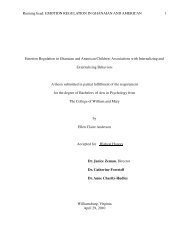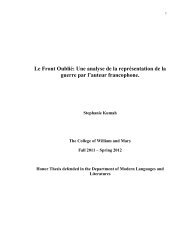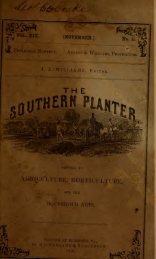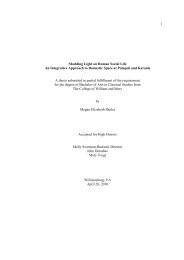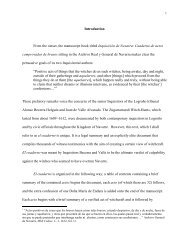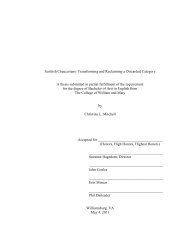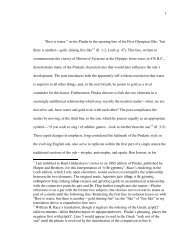Southern planter : devoted to agriculture, horticulture, and the ...
Southern planter : devoted to agriculture, horticulture, and the ...
Southern planter : devoted to agriculture, horticulture, and the ...
You also want an ePaper? Increase the reach of your titles
YUMPU automatically turns print PDFs into web optimized ePapers that Google loves.
with its inhaling <strong>and</strong> exhaling <strong>and</strong> separating<br />
powers. One of <strong>the</strong>se cases is as<br />
much a miracle as <strong>the</strong> o<strong>the</strong>r.<br />
To all l<strong>and</strong> animals, when alive, has<br />
been given <strong>the</strong> power of inhaling atmospheric<br />
air. While in <strong>the</strong> lungs it undergoes<br />
a chemical change— <strong>the</strong> oxygen inhaled<br />
combines with carbon derived from <strong>the</strong><br />
food, <strong>and</strong> is exhaled from <strong>the</strong> lungs as carbonic<br />
acid. This process goes on continually,<br />
<strong>and</strong> alike successfully in <strong>the</strong> wise man<br />
<strong>and</strong> in <strong>the</strong> idiot, in <strong>the</strong> sane <strong>and</strong> insane,<br />
asleep or awake ; <strong>and</strong> man is almost as unconscious<br />
of this operation as <strong>the</strong> brute ;<br />
<strong>and</strong> <strong>the</strong> brute is as unconscious of it as<br />
is <strong>the</strong> leaf, in reversing <strong>the</strong> order of this<br />
operation.<br />
From <strong>the</strong> foregoing physiological views,<br />
we are enabled <strong>to</strong> draw some useful <strong>and</strong><br />
practical hints in farm culture.<br />
As it is through <strong>the</strong> agency of <strong>the</strong> roots<br />
of plants that <strong>the</strong>y derive <strong>the</strong>ir moisture<br />
<strong>and</strong> earthly constituents, <strong>and</strong> about one-<br />
third of <strong>the</strong>ir carbon, it is rea^^onable <strong>to</strong><br />
suppose <strong>the</strong> greater <strong>the</strong> number of roots a<br />
plant has, <strong>the</strong> more rapid <strong>and</strong> larger its<br />
growth ;<br />
THE SOUTHERN PLANTER 427*<br />
for at <strong>the</strong> ends of <strong>the</strong> rootlets are<br />
placed <strong>the</strong> mouths of <strong>the</strong> plant for supplying<br />
it with that portion of its food derived<br />
from <strong>the</strong> soil ; <strong>the</strong>refore deeply worked<br />
<strong>and</strong> finely pulverized soil is much more<br />
favorable <strong>to</strong> a luxuriant growth of plants<br />
:<br />
(o<strong>the</strong>r conditions being equal,) than a<br />
hard, shallow-worked soil. In <strong>the</strong> well<br />
prepared soil <strong>the</strong> roots can freely penetrate<br />
every square inch of it in search of<br />
food <strong>and</strong> moisture every where disseminated<br />
through it, while <strong>the</strong> roots in <strong>the</strong> hard,<br />
ill-prepared soil will be few in number,<br />
feeble <strong>and</strong> stinted, <strong>and</strong> unable <strong>to</strong> supply<br />
<strong>the</strong> plant with food necessary <strong>to</strong> a luxuriant<br />
growth. After a farmer has prepared<br />
his l<strong>and</strong> in <strong>the</strong> best possible manner for a<br />
corn crop, can it be for his interest, at <strong>the</strong><br />
second <strong>and</strong> third time hoeing it, <strong>to</strong> run <strong>the</strong><br />
horse-plow or o<strong>the</strong>r deep-stirring imple-<br />
ment so as <strong>to</strong> sever or cut off a large<br />
portion of <strong>the</strong> roots of his growing corn ?<br />
We have witnessed such a performance<br />
many a time. Corn under such circumstances<br />
may, in favorable seasons, throw out<br />
new roots, <strong>and</strong> in part res<strong>to</strong>re <strong>the</strong> loss, <strong>and</strong><br />
a <strong>to</strong>lerable crop may be harvested, but it is<br />
our impression that such a course not only<br />
retards <strong>the</strong> growth, but lessens <strong>the</strong> amount<br />
of <strong>the</strong> crop. Why does <strong>the</strong> cabbage <strong>and</strong><br />
turnip plant wilt <strong>and</strong> droop when trans-<br />
27^<br />
planted.? 'Tis in consequence of having<br />
lost a portion of <strong>the</strong>ir roots <strong>and</strong> <strong>the</strong> exhalation<br />
of moisture by <strong>the</strong> leaf is greater<br />
than its supply by <strong>the</strong> mutilated <strong>and</strong> reduced<br />
number of roots.<br />
Every one that has transplanted evergreen<br />
trees knows how important it is <strong>to</strong><br />
preserve <strong>the</strong> fibrous roots <strong>and</strong> keep <strong>the</strong>m<br />
moist if <strong>the</strong>y expect <strong>to</strong> be successful in<br />
planting <strong>the</strong>m out.<br />
Cut off <strong>the</strong> root of a maple tree in " sap<br />
time," <strong>and</strong> <strong>the</strong> sap will flow from <strong>the</strong><br />
severed root as freely as it will from an<br />
auger hole bored in<strong>to</strong> <strong>the</strong> body of thti tree.<br />
Sever <strong>the</strong> roots of growing corn, <strong>and</strong> <strong>the</strong><br />
sap will ooze from <strong>the</strong> cut roots so as <strong>to</strong><br />
render <strong>the</strong> soil about <strong>the</strong>m quite' wet.<br />
This loss of moisture by <strong>the</strong> roots, with<br />
that escaping by evaporatioh by <strong>the</strong> leaves,<br />
causes <strong>the</strong> corn <strong>to</strong> wilt, <strong>and</strong> in very warih<br />
<strong>and</strong> dry wea<strong>the</strong>r, we have known <strong>the</strong><br />
leaves <strong>to</strong> become completely dried under<br />
'such management, while adjoining rows of<br />
corn, not having been disturbed by <strong>the</strong><br />
plow, remained unsca<strong>the</strong>d.<br />
As already observed, by <strong>the</strong> leavesMiie<br />
surplus water is exhaird, <strong>and</strong> carbonic<br />
acid inhaled <strong>and</strong> decomposed, <strong>and</strong> doubtless<br />
<strong>the</strong>re are o<strong>the</strong>r important chemical<br />
combinations <strong>and</strong> changes effected by <strong>and</strong><br />
I<br />
in <strong>the</strong> leaf. If so, is it good policy <strong>to</strong><br />
pluck from growing cabbages, beets, tur-<br />
nips, carrots, <strong>and</strong> o<strong>the</strong>r succulent plants, a<br />
portionof <strong>the</strong>ir<br />
hogs, &c.<br />
leaves for feeding cows,<br />
Is <strong>the</strong> quality of <strong>the</strong> grape improved,<br />
<strong>and</strong> its maturity hastened by removing a<br />
portion of <strong>the</strong> leaves from^ <strong>the</strong> fruit-bearing<br />
branches of <strong>the</strong> vine a month or so<br />
before <strong>the</strong> usual time of <strong>the</strong> ri[iening of<br />
\ <strong>the</strong><br />
j Will<br />
fruit } We have seen this plucking off<br />
<strong>the</strong> leaves of a grape vine performed<br />
more than once, from <strong>the</strong> mistaken idea<br />
that <strong>the</strong> fruit would be larger <strong>and</strong> earlier<br />
by <strong>the</strong> removal of a goodly portion of <strong>the</strong><br />
leaves of <strong>the</strong> vine.<br />
<strong>the</strong> crop of corn be as heavy <strong>and</strong><br />
(Valuable, ii <strong>the</strong> stalks are cut when <strong>the</strong><br />
kernels are in <strong>the</strong> milk, as if left uncut, or<br />
until <strong>the</strong>y had become dry? Says R. L.<br />
Allen:<br />
" The talks of corn ought never <strong>to</strong> be<br />
cut above <strong>the</strong> ears. The sap which nourishes<br />
<strong>the</strong> grain is drawn from <strong>the</strong> soil, <strong>and</strong><br />
passing through <strong>the</strong> stem, enters <strong>the</strong> leaf,<br />
where a material change in <strong>the</strong> sap takes<br />
place. This prepares <strong>the</strong> sap for conden-




